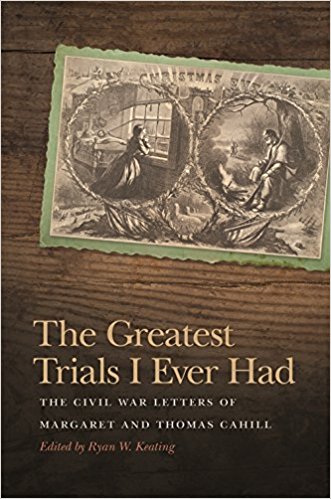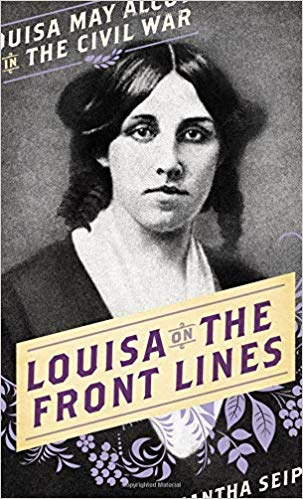The Greatest Trials I Ever Had: The Civil War Letters of Margaret and Thomas Cahill edited by Ryan W. Keating. University of Georgia Press, 2017. Paper, ISBN: 978-0820351551. $26.95.
 Good or even average collections of Civil War letters reveal why the period offers rich opportunities for students and scholars in a host of different fields, from traditional military history to social history, cultural studies, and medical history. Of equal importance, they present a human element to the war often missing in larger considerations of politics and strategy. Collections that include both a husband and wife’s missives are not that common, and collections from Irish American soldiers are all too few; therefore, the letters between Margaret and Thomas Cahill make up a quite rare source.
Good or even average collections of Civil War letters reveal why the period offers rich opportunities for students and scholars in a host of different fields, from traditional military history to social history, cultural studies, and medical history. Of equal importance, they present a human element to the war often missing in larger considerations of politics and strategy. Collections that include both a husband and wife’s missives are not that common, and collections from Irish American soldiers are all too few; therefore, the letters between Margaret and Thomas Cahill make up a quite rare source.
Margaret Lanin married Thomas late in the 1840s and by the eve of the Civil War, the couple had two young children. A successful businessman and militia captain, Thomas Cahill served as the colonel of the 9th Connecticut Infantry.
Having come of age during a period of mass migration and ethnic tension, Cahill and many members of his regiment displayed a fierce devotion not only to the American Union, but also to their Irish identity. Soon the regiment acquired a well-deserved reputation for disorder (including a fair amount of drunkenness among company officers), but eventually became more disciplined and soon headed for the Gulf of Mexico. Neither Thomas nor Margaret commented extensively on politics or the war’s larger questions, but Thomas made a number of passing remarks on slavery. “Infernal nonsense” (28) was his tart assessment of an early emancipation effort by Brigadier General John Phelps that also came under sharp criticism from the regimental chaplain, Father Daniel Mullen. Even though Mullen’s name oddly does not appear in the index to the volume, students of Civil War religious history will find interesting details on Mullen’s service in several of Cahill’s letters.
In a broader sense, this correspondence contains much information—mundane and otherwise—about life in a Civil War regiment. Cahill railed against the “infernal quartermasters” (35) who left his men wanting for shoes and underwear. Many of his letters mention the logistical details that bedeviled the lives of conscientious officers and refer to a host of problems surrounding promotions and duty assignments.
The regiment served on occupation duty in New Orleans and Baton Rouge, and Thomas described the civilians in the latter place as rather more civil than the more rebellious denizens of the Crescent City. While traveling along the Mississippi River on the steamer Diana he found the locals to be “perfectly wild” and wondered how long “it will take to restore them to the little sense they Ever had” (92). In Louisiana, the regiment reverted to its old ways and wracked up a remarkable number of courts martial. Thomas offers occasional comments on Benjamin F. Butler and Nathaniel P. Banks, while noting conflicts between various junior officers. Yet he found Louisiana a reasonably appealing place and even raised the possibility of moving south after the war; in the fall of 1863 Margaret and their three children joined him in New Orleans.
The 9th Connecticut eventually ended up in Virginia during the 1864 Shenandoah Valley campaign; by October 1864, Thomas Cahill had seen more than enough of the war and resigned his commission.
Both Cahills showed great concern about the irregular appearance of Union paymasters, and their letters are often filled with worries about finances and other problems of home life. Thomas believed he managed his affairs well and deposited much of his pay in the family bank account, though several people back home owed him money, and Margaret had to deal with renters who had fallen into arrears and a house fallen into disrepair. At one point, she tells her husband not to worry about the family finances (and she was right), but then proceeds to complain about the high prices of provisions. Like many a wife during the war, Margaret tried to ship various items—mostly clothes, shoes, and books—to her husband, though of course their safe arrival was often a matter of great uncertainty. In July 1862, Margaret gave birth to their son Matthew; Thomas remarked about being doubly blessed to receive this news on the heels of the Union capture of Baton Rouge. Margaret longed to hear how he was faring and welcomed a photograph. She longed even more for him to come home, and as Ryan Keating observes in his perceptive and valuable introduction, Margaret hardly fit the ideal of “the patriotic officer’s wife” (12).
Readers hoping for dramatic battle scenes or new information on military campaigns will be disappointed. But students of the war looking for insights into the connections between camp and home front will find the Cahills’ letters to be quite rewarding.
George C. Rable is Professor Emeritus at the University of Alabama and the author of many Civil War titles.
